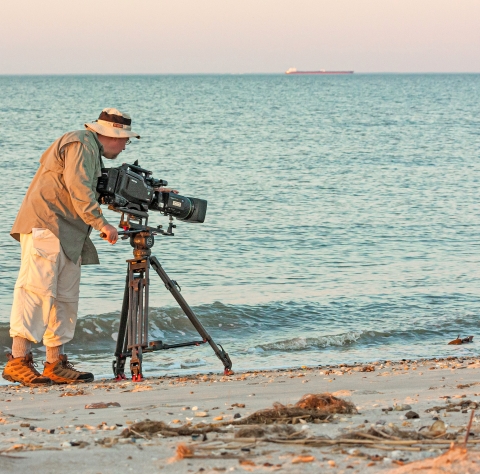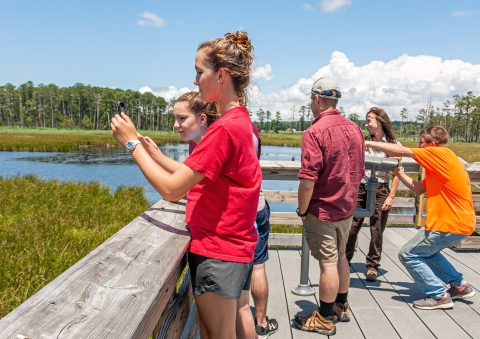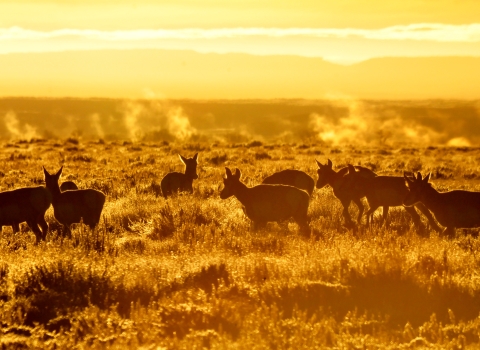Following an October 2022 decision by the U.S. Court of Appeals for the District of Columbia, on November 10, 2022, the U.S. Fish and Wildlife Service rescinded interim guidance that was established in response to litigation regarding commercial filming. At this time the Fish and Wildlife Service has resumed managing commercial filming and still photography in the National Wildlife Refuge System according to laws and regulations in 50 C.F.R. 27.71 (and 43 C.F.R. Part 5). This enables a national wildlife refuge national wildlife refuge
A national wildlife refuge is typically a contiguous area of land and water managed by the U.S. Fish and Wildlife Service for the conservation and, where appropriate, restoration of fish, wildlife and plant resources and their habitats for the benefit of present and future generations of Americans.
Learn more about national wildlife refuge manager to require a special use permit for commercial filming, and to collect and retain cost recovery charges associated with processing permit requests and administering the permit.
Commerical Filming
According to federal law, all commercial filming on lands and waters managed by the Fish and Wildlife Service requires a permit.
Commercial filming is defined as the film, electronic, magnetic, digital, or other recording of a moving image by a person, business, or other entity for a market audience with the intent of generating income.
Examples include, but are not limited to, feature film, videography, television broadcast, documentary, or other similar projects.
Commercial filming activities may include the advertisement of a product or service, or the use of actors, models, sets, or props.
Please contact the national wildlife refuge where you would like to film for more information and to inquire about the permit application process.
Non-Commercial Filming
Visitors can film on most, but not all, national wildlife refuges open to the public. At national wildlife refuges where filming is allowed (unless it is commercial filming as defined above), in most cases visitors do not need a permit when filming for personal enjoyment.
Non-commercial filming may require a special use permit in some circumstances. For example, a permit may be required if:
- the activity, equipment, actors, models or other participants/group members may disturb or damage natural or cultural resources
- the participants use more extensive filming equipment than hand-held cameras or cameras supported by hand-held tripods (more extensive filming equipment could include sets, props and camera equipment that is too heavy to be hand-carried)
- the people in the filming group, their associated equipment and the filming activities may interfere with refuge operations or the general public’s enjoyment of the resources
- filming involves the use of artificial lights or audio equipment
- the filming activity may violate the Endangered Species Act, the Migratory Bird Treaty Act, the Archaeological Resources Protection Act, the Wilderness Act, or any other federal statute or regulation
- the planned filming activity will occur in closed areas or occur at times when all or part of the refuge is closed to all or some members of the public
- filming will occur inside a facility such as a visitor center or headquarters office
- the activity may affect public health or safety
Newsgathering filming, videography or still photography activities do not require permits in most cases, unless the refuge manager determines a permit is necessary to protect natural and cultural resources, to avoid visitor use conflicts, to ensure public safety or authorize entrance into a closed area.
Because the U.S. Fish and Wildlife Service manages filming and other public activities on a site-specific basis, if you will need a filming permit, or if you are unsure as to whether your planned filming falls into any of the above categories, please contact the refuge manager well in advance of the date you would like to film.
Special Considerations
Wilderness:
Except when visitors are filming casually (see circumstances under Non-Commercial Filming above when permits may be required), special use permits are required for all filming activities in refuge wilderness areas. Please contact the refuge in advance if you wish to film in a recommended, proposed or designated wilderness area wilderness area
Wilderness areas are places untamed by humans. The Wilderness Act of 1964 allows Congress to designate wilderness areas for protection to ensure that America's pristine wild lands will not disappear. Wilderness areas can be part of national wildlife refuges, national parks, national forests or public lands managed by the Bureau of Land Management.
Learn more about wilderness area .
Alaska:
In addition to the laws that govern management of all national wildlife refuges, Alaska has specific laws that you should know and understand. Alaska refuge managers rely on the Alaska National Interest Lands Conservation Act of 1980 (ANILCA) and regulations codified in 50 C.F.R. Part 36 to manage filming activities.
For example, unique to Alaska, ANILCA requires that the U.S. Fish and Wildlife Service protect subsistence resources and traditional uses. Identifying and acknowledging the traditional, and in some places, sacred, uses of these lands and waters, is paramount to managing these units of the National Wildlife Refuge System.
Please contact the refuge in advance to discuss filming activities if you have questions about Alaska rules and regulations.









